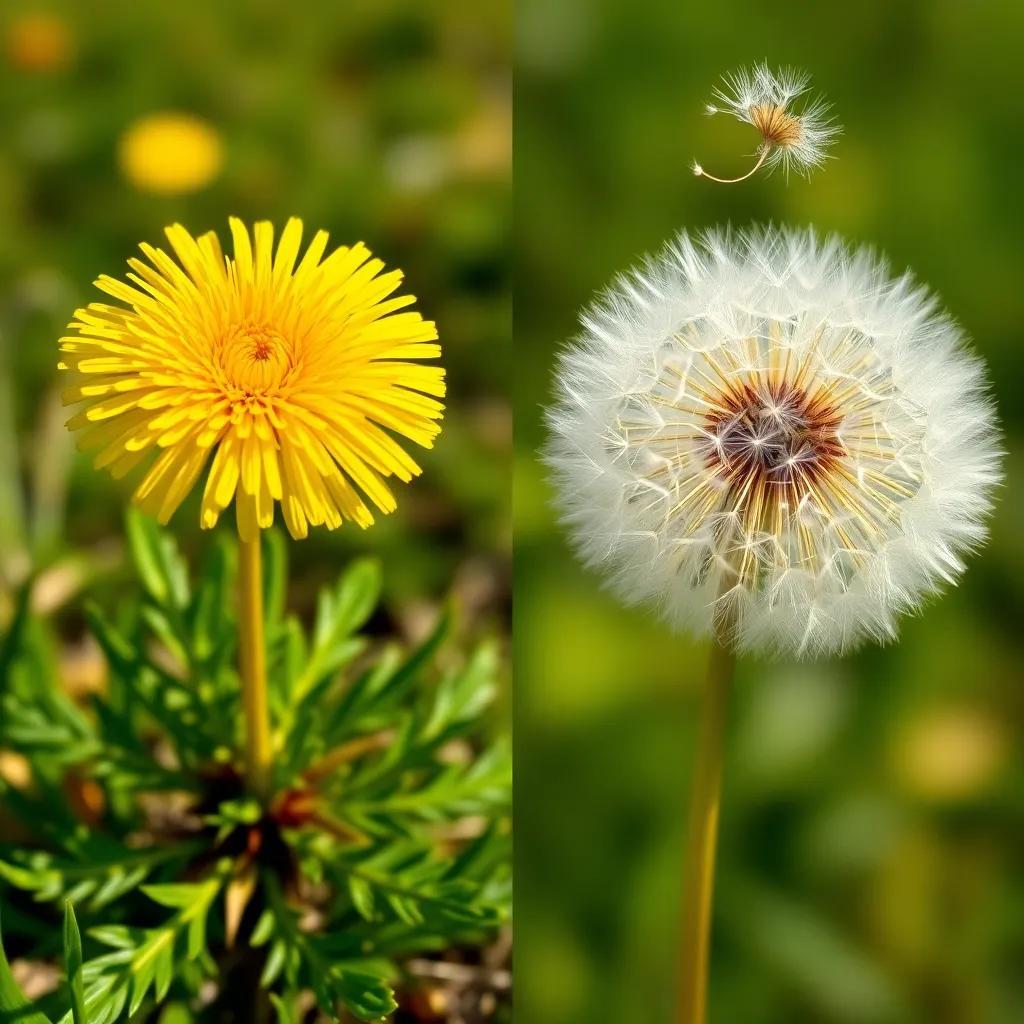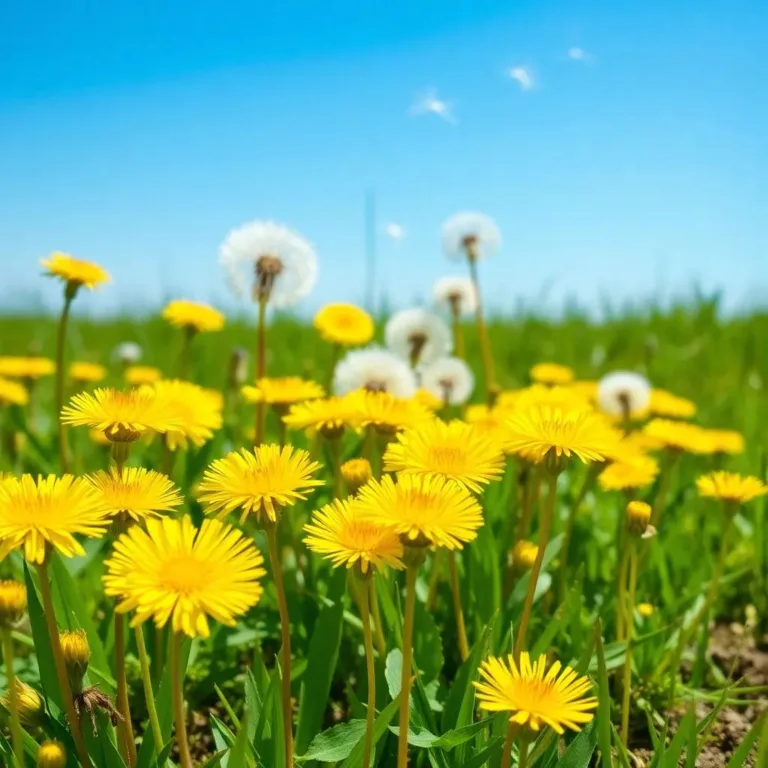Have you ever watched dandelions float through the air and wondered how they spread their seeds? These cheerful little plants have some amazing tricks up their sleeves! Join me as we explore the fascinating world of dandelion seed dispersal and discover the incredible ways they thrive in our gardens and beyond!
Anatomy and Life Cycle of Dandelions
Let’s take a closer look at the anatomy and life cycle of dandelions, those cheerful little yellow flowers that turn into fluffy white puffballs! Dandelions, known scientifically as Taraxacum officinale, have a unique structure that helps them thrive in many environments.
Key Parts of a Dandelion:
- Taproot: This deep root system digs down into the soil, helping the plant gather essential nutrients and water. It’s like a super straw that goes deep into the ground!
- Leaves: The leaves form a rosette close to the ground. They’re deeply lobed and help the plant soak up sunlight through photosynthesis. Think of them as dandelion solar panels!
- Flowers: The bright yellow flowers are made up of many tiny florets. When they bloom, they create a stunning display that attracts pollinators like bees and butterflies. These little buddied help dandelions reproduce by spreading pollen.
Once the flowers bloom, they eventually transform into those iconic puffballs. Each puffball is packed with seeds just waiting for the wind to carry them off.
Now, let’s talk about the dandelion’s life cycle, which is a fascinating journey:
- Seed Dispersal: The adventure begins when the dandelion seeds are released from their puffballs. They can be carried far away by the wind, or even raindrops can help pop them off!
- Germination: If a seed lands in a sunny, nutrient-rich spot, it can sprout! The seed sends down a taproot to anchor itself.
- Growth: Over time, the dandelion grows leaves that collect sunlight and form a new flower.
- Maturity: Once mature, the cycle starts again as the dandelion blooms, setting the stage for the creation of more seeds.
Isn’t it amazing how dandelions have adapted to spread their seeds and thrive? These little plants may seem simple, but they have a life cycle that’s anything but ordinary!
Primary Seed Dispersal Methods
Now, let’s jump into the exciting world of how dandelions spread their seeds! Their main method of dispersal is through wind, but they also have a few tricks up their sleeves. Here’s how they manage it:
- Wind Dispersal: The most famous method! Dandelion seeds are super lightweight and equipped with fluffy structures called pappus. When the wind blows, the seeds ride along like little kites, traveling far and wide. It’s like they’re saying, “Catch me if you can!”
- Animal Assistance: Believe it or not, animals help too! When furry friends, like rabbits, brush against dandelion puffballs, seeds can cling to their fur and be transported. These furry couriers have no idea they’re helping dandelions spread!
- Human Helpers: Guess what? We humans also contribute! Dandelion seeds can attach to our clothes, shoes, or even gardening tools. It’s like a surprise gift of nature that we carry to new locations!
Dandelions have some clever strategies to make sure their seeds find new homes. Here’s a quick recap:
- Wind Power: Seeds float away, carried by the breeze.
- Animal Friends: Furry creatures unknowingly transport seeds.
- Human Transporters: Our clothes and tools help seeds travel.
So, the next time you see a dandelion puffball floating through the air, remember all the methods it uses to spread its seeds! Isn’t nature fantastic?

The Role of Wind in Seed Dispersal
Wind is the superstar when it comes to dandelion seed dispersal! These fluffy seeds have evolved perfectly for this journey through the air. Just imagine a sunny day, with a gentle breeze blowing. When a dandelion puffball matures and the seeds are ready, they become like tiny hot air balloons, eager to take flight!
Here’s how it works:
- Lightweight Seeds: Dandelion seeds are super lightweight. This means they can be picked up by even the lightest gust of wind!
- Pappus Action: Each seed is attached to a feathery structure called the pappus. This acts like a parachute, increasing the surface area and catching the wind. It’s like the seeds are wearing tiny capes, soaring through the breeze!
As the wind carries these seeds away, they can travel long distances. Some seeds have been known to travel over a mile! Talk about an epic journey!
Additionally, the wind doesn’t just help seeds travel. It also helps them find new homes. When seeds land in a sunny spot with good soil, they can start the whole process over—germinating, growing, and blooming into new dandelions. Isn’t nature fantastic? So, next time you see a puffball dancing in the wind, remember the role it plays in the life of a dandelion!
External Forces Aiding Dandelion Spread
While wind is a key player, dandelions have some clever ways to use external forces to help them spread their seeds! Nature is full of surprises, and dandelions make the most of them. Let’s explore these fascinating forces that join in the seed-spreading fun!
- Raindrops: Believe it or not, raindrops can act as little seed launchers! When it rains, the impact of the drops hitting a puffball can cause seeds to get flung away from the parent plant. It’s nature’s version of a slingshot!
- Animal Helpers: Animals are surprisingly helpful too! If a dog or a rabbit brushes against a dandelion puffball, the seeds can stick to their fur. As the animal moves around, it carries the seeds to new locations, where they can settle down and grow. Furry friends are excellent seed transporters!
- Human Influence: You guessed it—humans play a part in dandelion seed dispersal too! When we walk through dandelion patches, seeds can easily cling to our clothes or shoes. Before we know it, we’ve unknowingly transported dandelion seeds to new gardens or parks! We might even help them spread without even realizing it!
All these external forces work together to create the perfect conditions for dandelion seeds to find new homes. Isn’t it incredible how interconnected everything is? The next time you see dandelions, think about all the little ways they use nature and our actions to spread their seeds far and wide!
Impacts of Human Activities on Dandelion Seed Distribution
Humans and dandelions share a unique relationship, and this connection has a big impact on how these resilient plants distribute their seeds. Let’s explore how our everyday activities influence their spread!
First off, consider how we interact with our environment. When we engage in activities like gardening or landscaping, dandelions can sometimes hitch a ride. Their seeds can stick to our tools, clothing, or even our pets! Here are some things to think about:
- Mowing the Lawn: When we mow, we might accidentally break off puffballs, sending seeds flying all over the place. One moment you’re tidying up, and the next, you’ve helped spread dandelions across the neighborhood!
- Gardening Tools: Tools can also transport seeds. If you use a rake or shovel in an area with dandelions, seeds can stick to them and get moved to a new location. Oops! Seeds may end up in your carefully tended flowerbeds!
- Foot Traffic: Our own footsteps can help too! Just walking through a field of dandelions can easily dislodge seeds, letting them take flight into new spaces.
Despite often being labeled as weeds, dandelions actually bring some benefits to our gardens. They attract pollinators, improve soil health, and can even be used in cooking! Understanding how human activities influence seed distribution allows us to appreciate and manage these plants better.
So, the next time you spot a dandelion puffball, remember how our simple actions and interactions with nature can help or hinder their journey! It’s all part of the big picture in our gardens and beyond!

